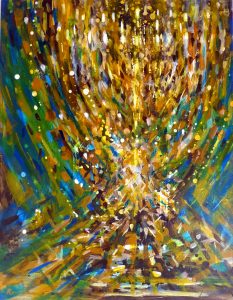A Book Out of the Ashes
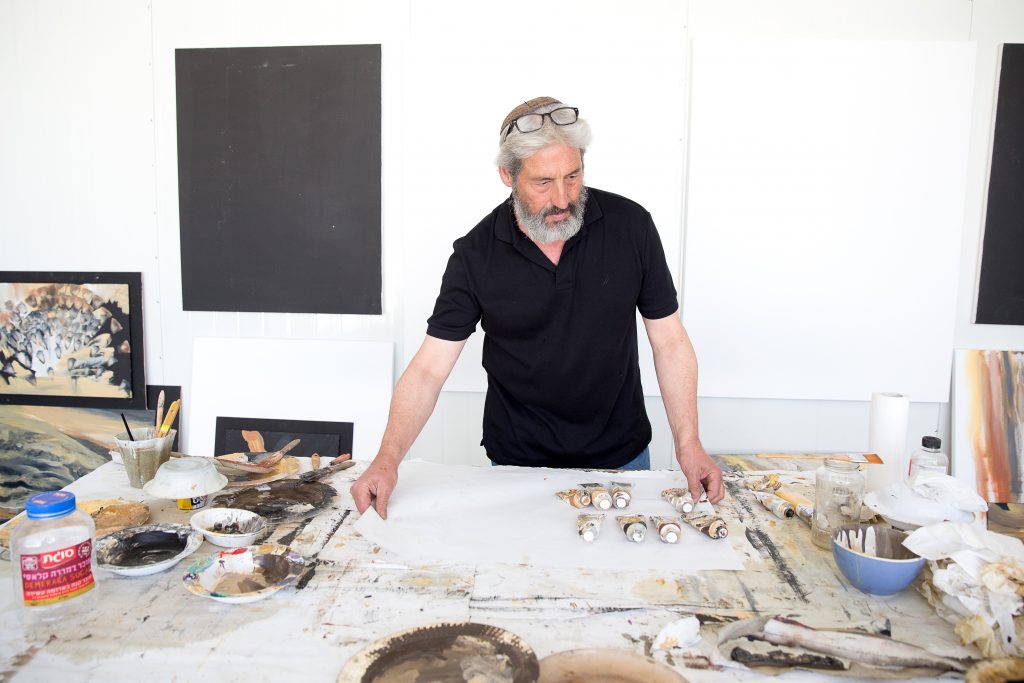
“The process of making art is one of creation and destruction,” says Yoram. “I turn it upside down, I do it different ways. I cover [the painting] over. Sometimes I think I have a painting and then in the end it doesn’t work and it gets destroyed and something better comes out of it.” Photo: Jared Bernstein
Artist Yoram Raanan created a magnificent book of paintings on the parshiyot, following a devastating fire
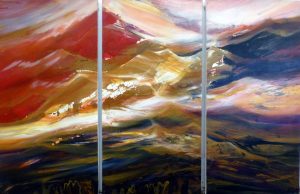
“Dialogue of the Mountains” was inspired by the midrash in Bereishit Rabbah, in which the mountains argue on which one the Torah will be given. It is composed of three canvases together, in dynamic reds and oranges and golds and browns. Meira writes, “…the air is crackling with anticipation. Something is about to happen here; something life-changing.” Photos: Yoram Raanan
The winding road up from the Jerusalem-Tel Aviv highway to Moshav Beit Meir, a picturesque moshav located twenty minutes west of Jerusalem, looks out on some of the most beautiful foliage in Israel—a lush, ethereal setting in which an artist can lose himself and find the soul in his art. And this is what Yoram Raanan did, living with his wife, Meira, and his family in this utopian atmosphere, painting in his studio (formerly a chicken coop) and eventually becoming one of the most celebrated Jewish artists worldwide.
And then one day in November 2016, a fire erupted, devastating large forest areas and burning Yoram’s studio down to the ground, taking with it more than 2,000 paintings.
As the couple sped down the mountainside in their car, fearing for their lives, Meira heard her husband calmly utter the words that have by now become legendary: “There goes the studio.”
In the days and months that followed, as they put their lives back together, people around the globe heard Yoram’s story.
Miraculously, the treasures that went up in smoke, rather than becoming only ashes and memories, served as the fiery impetus for Yoram to soar.
The destruction of much of Yoram’s life’s work resulted in a magnificent coffee table book, Art of Revelation: A Visual Encounter with the Jewish Bible, consisting of his 160 exquisite parashah paintings. All of the paintings had been burned, but fortunately, he had photographed these earlier—sometimes professionally, sometimes with his own camera. (Most of his paintings had not been photographed.)
Yoram built a new studio. He received new commissions. He threw new passion into his art. He said “gam zu l’tovah—this too is for the best,” and his hishtadlut turned it into a self-fulfilling prophecy.
The Beginning
Yoram was not always well known; he lived for many years as the quintessential struggling artist. He began to paint at the age of two, he says, “like most children.” But he knew it was his calling from the age of sixteen, when, he says, “I left the world of ice hockey and went into art.” He grew up in New Jersey, graduated from the University of Arts in Philadelphia, and then began to travel the world, studying art along the way in Europe and the Near East. In 1977, he found himself in Israel. He spent a short time at Aish HaTorah in Jerusalem, before moving on to the beaches and sand dunes of Sinai. From Sinai he went to Ohr Somayach, where he stayed for two years, becoming shomer Shabbat, he says, during the second year on Shavuot, when he experienced what he describes as “an epiphany.” Suddenly, he knew: “This is me.”
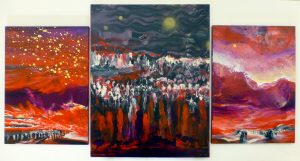
“Masei,” composed of three canvases, depicts the people of Israel going to the Promised Land. Describing the magnificent work, Meira writes that the journey begins with a desert sky that “flames with passion” to a canvas in which they are walking toward swirls of light, culminating in a panel with a sunrise above the Land of Israel, “which rises before them in exulting curves.”
He was introduced to his wife Meira, currently a researcher and writer, who had made her own journey. Recalling her days as a student at Hebrew University, Meira confesses, “I had one foot in and one foot out of religion. I started learning at Bruria [today Midreshet Lindenbaum]. Then I had both feet in.”
They married, and the early years were lean as they tried to make ends meet while Yoram pursued his passion. They had four children and ultimately settled in Moshav Beit Meir, where they have lived for the past twenty-five years. “I’m not a city person. I like nature, the quiet,” says Yoram.
Where did Yoram get the faith, the strength to be able to say “gam zu l’tovah” after the devastating fire?
“I believe that God is good, and everything is for the good; He’s running the show,” he says. “These are things that we say every day in tefillah, so how can you not feel this way? [Look at] Shir Hama’alot [Psalm 126]. When we come back it’s going to be like we’re in a dream. And life is pretty dreamy in a way because it goes by so quickly. Do you even remember what happened yesterday? And then we have this terrible long exile, but we’re going to be laughing, we’re going to be so happy, semechim. So if you’re saying [this tefillah] every day or at least on Shabbat… If you’re a practicing Jew, what’s the difficult part?
“I’ve learned a lot from hishtadlut because I tried so hard for many years to make a living as an artist. It’s not easy, though now, baruch Hashem, it’s much easier than it once was.”
Yoram painted in Israel for forty years with “a lot of ups and downs,” not selling anything sometimes for months on end, traveling to America and returning empty-handed, having a work commissioned and then abruptly canceled, having a meeting look promising and ending in nothing. Disappointment after disappointment plagued him, as well as increasing debt.
“And then I got a call from a woman in Pittsburgh, who said, ‘I’ve been wanting to buy one of your works for so many years. We’re coming to Israel in a few weeks. Would it be okay if we came to the studio…?’ I’m like, ‘Yeah! It’ll be okay!’ They came, and she brought her parents as well. They ended up commissioning a painting for the exact same price as the one that had been canceled—$8,000. And her parents bought two pieces of art and commissioned another two pieces.
“Nothing came from all the [hishtadlut] I had done and then, poof, min haShamayim, I had this little mini-geulah [redemption],” he says.
“Eventually things evened out through the years. I saw from that why you’re supposed to do hishtadlut—to see that Hashem runs the world. I’m just an actor and not the director.”
Things took off. Yoram received lucrative commissions, built up an exclusive clientele and began to exhibit throughout the world. His works can be found in the Waldorf Astoria Hotel in Jerusalem and the Wolfson Museum of Jewish Art in Jerusalem, as well as in high-end galleries and private collections.
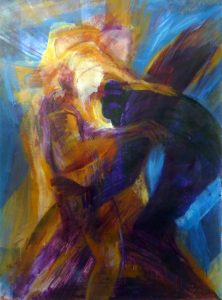
“Jacob Wrestling with Angels” Describing the painting, the book notes: “At the end of the struggle, when the darkness of dawn had passed, a light shone on Jacob and he did not let the figure go until he blessed Jacob with a new name . . . Counterpoised over the deep-blue background, a warm, gold light predominates over the tense conflict of the night-long encounter. This battle is symbolic of each person’s wrestling with his or her darker side, and shows how blessing and light often come through struggle.”
The Process
In the opening to Yoram’s book, Rabbi Lord Jonathan Sacks writes: “Few artists in the Jewish world today better capture the beauty of holiness, avodah and of Judaism as a faith than Yoram Raanan . . . these works of art are Yoram’s commentary to the Torah, and to the spiritual dimension of our life and Land. He helps us ‘see that it is good,’ showing us the light of holiness and the beauty of being.”
“The process of making art is one of creation and destruction,” says Yoram. “I turn it upside down, I do it different ways. I cover [the painting] over. Sometimes I think I have a painting and then in the end it doesn’t work and it gets destroyed and something better comes out of it.” He tells the story of a painting he had hanging in a hotel, but the manager said it was too abstract and they needed something “more Jewish.” “Well, you can see the heavens,” [Yoram] said, “and that’s an eagle flying through the sky, and you know, Bnei Yisrael were on eagles’ wings.” The manager wasn’t convinced and gave it back to him. Yoram went back to his studio frustrated, threw green paint all over the painting (it was mostly blue), then a bucket of water, and he worked on it. “And this image, this face of Esther appeared, and then as I was clarifying the image, all of a sudden I saw this Mordechai figure behind her. So I brought that out a little. That’s an example of why I have no preconceptions whatsoever. A lot of these paintings that I paint, I don’t paint,” he says, implying that they come from Above.
After the fire, the editor of the Jerusalem Post asked if they could run a few of Yoram’s paintings in the weekend magazine. “Some billionaires noticed them. They commissioned six large paintings,” said Meira. “It was like some people had told me—fire brings wealth.”
Yoram believes he was able to bounce back financially because so many people were deeply moved by his story and prayed for his success. He was happy to rebuild his studio as he saw fit, not as a refurbished chicken coop.
Because the fire was regarded as an act of terror, Yoram received some funding from the Israeli government to rebuild his studio. But he did not get any compensation for the lost canvases, which generally range in price from $3,000 to $50,000. Yoram shows me around his newly built studio, which has high ceilings and is constructed from better quality materials. I try to identify which painting is Jerusalem, which depicts a flood, and who the Biblical characters are in each. Yoram says he enjoys seeing people try to interpret his art.
He’s worked on some paintings for twenty-five years. On the other hand, “Every once in a while I can do a painting in twenty minutes,” he says. “A good one.”
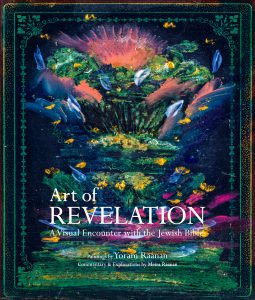
Art of Revelation: A Visual Encounter with the Jewish Bible contains photographic reproductions of exquisite paintings that were done in oil, acrylic and mixed media on the fifty-four parshiyot of the Torah. On a page facing each painting, there are explanations and commentary compiled by Meira.
The Book
Art of Revelation: A Visual Encounter with the Jewish Bible contains photographic reproductions of exquisite paintings that were done in oil, acrylic and mixed media, on the fifty-four parshiyot of the Torah. Some Biblical stories have several variations, such as three paintings of the creation of Adam and Eve, three of keruvim, many paintings of the menorah, and several of the Cave of the Patriarchs. Each painting expresses something different through its colors and shading, the movement of the brush. The facing page to each painting provides explanations and commentary compiled by Meira. “Everything that’s written in this book is based on interviews, what Yoram told me he was thinking and feeling about each of the paintings,” says Meira. And then there was my own research into each subject, and putting it all together.”
Meira’s prose is as rich in its use of language as Yoram’s paintings are rich with color. A teacher of religion and meditation, she is working on another book, The Lights of Fire, on the subject of the blessings that have emerged from the fire that destroyed Yoram’s studio and its contents.
Rembrandt, Picasso, the abstract expressionists and the New York School of artists in the 50s all influenced Yoram’s engaging artistic style, but Yoram is unique in that he expresses Torah through his art. How does he do that? “I read through the parashah and find things that I want to research,” he says. “Then I look through all my paintings. Sometimes I paint over paintings, or use old paintings, or I collage paintings together. And I find things that could go with that parashah or that pasuk or that idea. And then I read as many commentaries as I can to get ideas and find them in the painting and bring those out.
I saw from that why you’re supposed to do hishtadlut—to see that Hashem runs the world. I’m just an actor and not the director.
“I had done a series of paintings on the days of Creation. I came to day two, the separation of the waters, and I had a large painting that had a watery feeling to it, but it lacked the idea of separation. So I found another painting that was sort of watery. I only wanted part of it, so I tore it in half and I pasted it on top of the first painting. Afterwards I found a commentary that said that Hashem tore the heavens, or something like that. All of a sudden, the ragged paper that I’d pasted on top of the original painting had meaning to it.
“That’s an example of how I put another level of meaning into a painting without even realizing that I’m doing it. I’m not a talmid chacham, but I find that somehow I get a certain energy, so to speak . . . .”
Yoram paints with his fingers, his hands and brushes of different sizes, including house paint brushes, a palette knife and an Israeli spongee stick.
He describes an entire series he did on canvas with his hands, of people praying and dancing on Simchat Torah. “What I like about using my hands is that I can do the work very quickly, and I fill up the whole canvas and use the side of my hand and all of a sudden there are people and chandeliers.
“Since the fire,” he says, “I only want to create art when I really believe and feel it. I have to make a living, so when I get a commission to do very well-paid work, I take it. But I’m a little torn between making a living and just being a pure expressionist artist.” As for the future, he hopes his art will become more accessible and more affordable so more people can enjoy it. “They’re coming up with new printing techniques that can make pieces as exciting and dynamic as the originals, and they’ll become much more affordable than the originals.”
To Yoram, one’s spiritual journey is never ending. “That’s what it is if you’re a Jew. It’s like Yisrael fighting with God. We have to grow, to develop as people, to wrestle, to live a very active life. You don’t sit still.”
Meira concurs, “We all have fires in our lives, and hopefully they’ll be opportunities for growth.”
Toby Klein Greenwald, a regular contributor to Jewish Action, is a journalist, playwright, poet, teacher, and the artistic director of a number of theater companies. She is the recent recipient of the Lifetime Achievement award from Atara-The Association for Torah and the Arts for her “dedication and contributions in creative education, journalism, theatre and the performing arts worldwide.”

